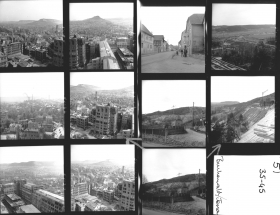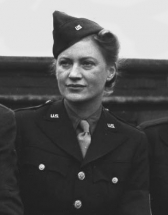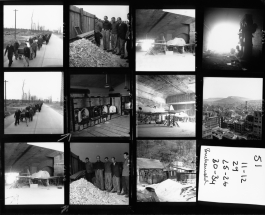The “REIMAHG”, occupied and guarded by the Allies since mid-April, is also the focus of the international press. Together with other journalists and photographers, photographer Lee Miller is on tour in Thuringia at the beginning of May. Lee Miller, born in Poughkeepsie (New York, USA) in 1907, was already familiarized with the many aspects of photography by her father as a child. In 1926 she began a very successful career as a model in Manhattan. Her photos appear in magazines such as Vanity Fair and Vogue. During this time she works closely with the photographers Edward Steichen and George Hoyningen-Huene.
In 1929 she moved to Paris. Here, she quickly feels comfortable in the progressive art scene, where she meets the painter and filmmaker Man Ray and has a brief romance with him. She stays in Paris and works as a portrait and fashion photographer. In 1932 she went back to New York and founded her own photo studio. She met the Egyptian businessman Aziz Eloui Bey, married and went with him to Cairo in 1935. During this time, her most impressive photographs are created, which are shaped by surrealism.
After two years, her marriage is divorced and she goes back to Paris where she meets the artist Roland Penrose, her future second husband. Their close cooperation takes them all over Europe, where they also meet Picasso. In 1939, shortly before the outbreak of World War II, they are in London. She returns to New York and now works as a photographer for Vogue.
In 1944, Lee Miller was accredited as one of the few female military correspondents in the U.S. Army, working closely with photographer David E. Sherman, who worked for Time-Life and Vogue. They cover the liberation of Paris, the meeting of the U.S. with the Red Army in Torgau as well as the capture of the Berghof in Berchtesgaden and the liberation of Buchenwald and Dachau. In Munich, in April 1945, a photo of her, taken by Sherman, was taken, which became an icon. Lee Miller is seen sitting in a bathtub, pictured in Hitler’s private apartment.
After her stay in Munich, she moves on and is 45 in Thuringia in May. Here she captures the horrors of Buchenwald concentration camp in photos. Her way leads her to Jena, where she mentions many bomb damage in her diary. In this she also describes her subsequent visit to the “REIMAHG”.
Together with other well-known female photographers, she inspects and photographs this facility. She takes photos of Bunker 0, which still has some half-finished Me-262s, as well as the grounds at Walpersberg. In memory, she takes a pair of scissors from “Stelle O”.
In 1947 she married Anthony Penrose and move into a house in England. In the same year, their son Anthony was born. She continued to work for Vogue and Life in the following years. She died of cancer on July 21, 1977.
Today, her photographic heritage is managed by her son Antony.
Our association has been in close contact with the son of Lee Miller for many years.




